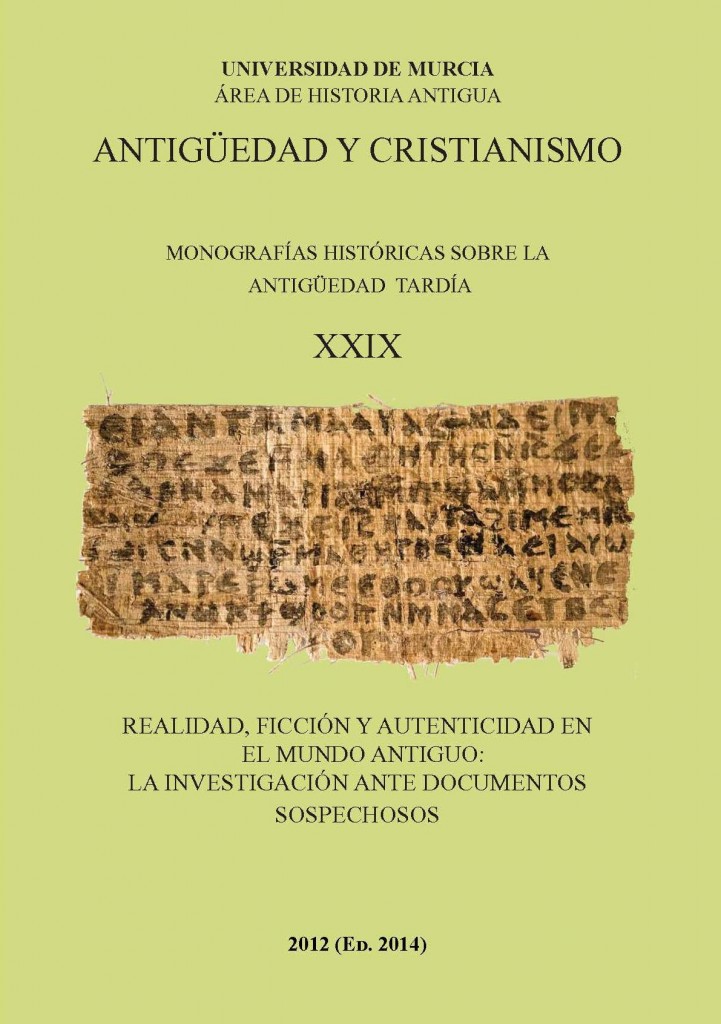La atracción de la falsa palabra y del código prohibido en Margaret Atwood: Nolite te bastardes carborundorum
Resumen
Un falso epígrafe, encontrado semioculto por una esclava en un régimen totalitario futurista, desencadena el leitmotiv principal de una rebelión silenciosa en la novela El cuento de la criada de Margaret Atwood (1985). Este es el modo en que se revela un fondo de crítica y reivindicación social y cultural mediante una inscripción en latín macarrónico: Nolite tebastardes carborundorum. Se señalan además otros lemas y grafitos “leídos” por una autora que,siempre interesada por las trampas y vericuetos del lenguaje, juega con cierta frecuencia con el falso literario epigráfico.
Descargas
-
Resumen605
-
PDF398
Citas
A. DAVIDSON, “Future Tense: Making History in The Handmaid’s Tale”, en K. Van Spanckeren-J. Garden (eds.), M. Atwood: Vision and Forms, Carbondale 1988, pp. 113–121
A. MALAK, “Margaret Atwood’s The Handmaid’s Tale and the Dystopian Tradition”, Canadian Literature 112 (1987), pp. 9–16
D. D. DODSON, “An Interview with M. Atwood,” Critique: Studies in Contemporary Fiction, 38, 2, 1997, p. 101
D. S. HOGSETTE, “Margaret Atwood’s Rhetorical Epilogue inThe Handmaid’s Tale: The Reader’s Role in Empowering Offred’s Speech Act”, Critique 38, 1997, pp. 262–78.
H. F. BERGMANN, ““Teaching Them to Read”: A Fishing Expedition in The Handmaid’s Tale”, College English 51, 8, 1989, pp. 847–854
J. W. GRAHAM (ed.), V. Woolf. The Waves: The Two Holograph Drafts, Londres 1976, p. 417
J.-P. PICOT, “Féminité et contre-utopie”, Les Cahiers du GRIF 47, 1993, p, 87
L. FEUER, “The Calculus of Love and Nightmare: The Handmaid’s Tale and the Dystopian Tradition”, Critique, 38:2, 1997, pp. 83–95.
L. HUNTER, “‘That Will Never Do’: Public History and Private Memory in Nineteen Eighty-Four and The Handmaid’s Tale”, en M. Dvorak (ed.), The Handmaid’s Tale: Margaret Atwood, París 1998, pp. 19–29.
L. M. YORK, “The Habits of Language: Uniform(ity), Transgression and Margaret Atwood”, Canadian Literature126, 1990, pp. 6–19
L. S. KAUFFMAN, Discourses of Desire: Gender, Genre, an Epistolary Fictions, Ithaca–Londres 1986
M. ATWOOD “An End to Audience”, The Dalhousie Review60, 1980, pp. 432
M. ATWOOD, “Genesis of The Handmaid’s Tale and Role of the Historical Notes”, en J.-M. Lacroix et al. (eds.), The Handmaid’s Tale, Roman Protéen, Ruén 1999, pp. 7–14; y “The Handmaid’s Tale and Oryx and Crake in Context”, PMLA 119.3, 2004, pp. 513–17
M. ATWOOD, “Witches”, en Second Words. Selected Critical Prose. Toronto 1982, p. 332
M. K. BOOKER, Dystopian Literature: A Theory and Research Guide, Westport 1994
M. LACOMBE, “The Writing on the Wall: Amputated Speech in Margaret Atwood’s The Handmaid’s Tale”, Wascana Review 21, 2, 1986, pp. 3–20
M. MAYER, “La técnica de producción de falsos epigráfi cos a través de algunos ejemplos de CIL II Excerpta Philologica 1, 2, 1991, pp. 491–499
T. FINIGAN, “’Into the Memory Hole’: Totalitarianism and Mal d’Archive in Nineteen Eighty-Four and The Handmaid’s Tale”, Science Fiction Studies 38, 3, 2011, pp. 435–459.
V. PROVENCAL, “Byzantine in the Extreme”: Plato’s Republic in The Handmaid’s Tale”, CML 19, 1, 1988, pp. 53–76
W. G. GARRETT-PETTS-D. LAWRENCE, Photographic Encounters. The edges and edginess of reading prose pictures and visual fi ctions, Edmonton – Kamloops, 2000
1. Los autores ceden de forma no exclusiva a la revista los derechos de explotación (reproducción, distribución, comunicación y transformación).
2. Las obras que se publican en esta revista están sujetas a la licencia Attribution-ShareAlike 4.0 International (CC By SA 4.0). Por lo que se pueden copiar, usar, difundir, transmitir y exponer públicamente, siempre que:
i) se cite la autoría y la fuente original de su publicación (revista, editorial y URL de la obra), permitiendo así su reconocimiento.
ii) se permite remezclar, transfromar o crear a partir del material mientras se mantenga la misma licencia del original.
Nota: Los artículos anteriores a 2022 muestran incorrectamente la licencia CC by SA en la página de resumen. Están bajo una licencia CC by NC ND tal y como se incluye en los pdfs de los artículos. Los artículos publicados en 2022 y después están bajo la licencia CC by SA.

3. Condiciones de auto-archivo. Se permite y se anima a los autores a difundir electrónicamente las versiones pre-print (versión antes de ser evaluada) y/o post-print (versión evaluada y aceptada para su publicación) de sus obras antes de su publicación, ya que favorece su circulación y difusión más temprana y con ello un posible aumento en su citación y alcance entre la comunidad académica. Color RoMEO: verde.
























